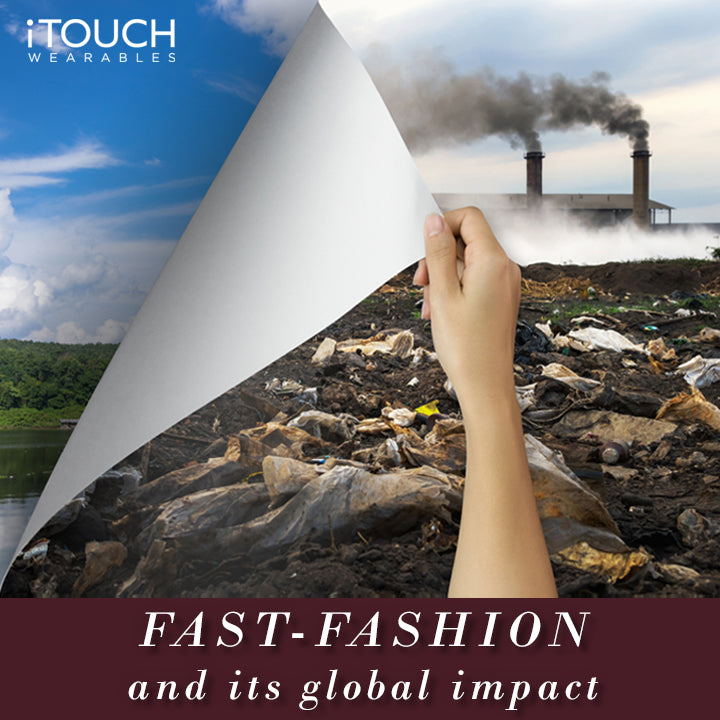
Fast-Fashion and Its Global Impact
Within the past fifteen years, the global fashion industry has doubled in size, the need for new clothing and product exponentially growing more than ever. But due to the short lifecycle of most mass produced clothing, we has a society are throwing out and getting rid of clothing increasingly more than we ever had in the past. The United States alone had sent more than 9.5 million tonnes of clothing to a landfill within the past year, which out of that 9.5 million tonnes, 95% of the clothing could have been recycled or reused. That shocking thing is, that only less than 1% of it actually is. In an effort in trying to figure out why, the Ellen MacArthur Foundation, a UK-based charity in which they aim to work with business, government, and academia to build a framework in which to support a "restorative and regenerative economy", conducted a study in which they found that clothing's utilization (or the amount of times clothing is worn repeatedly) had declined by 35% over the years, leading to the climbing rates of clothing waste. Instead of acting in repairing our clothing, we repurchase cheaply-made alternatives and replacements. In doing so, we are contributing to the rise of fast-fashion, creating a massive impact on our global society.
What Is Fast Fashion?

Fast Fashion is the result of high-street fashion industry adapting a model in which the produce a "quicker and cheaper" alternative to their clothing. Business such as Forever 21, H&M, and Zara have claimed to be the major contributors to this model, in which they produce huge quantities of cheap product, being released all year round compared to the classic business model of releasing collections every summer or winter. Due to this demand and the increase of the need for clothing, textile distributers and suppliers are being pressured into producing clothing with much more tighter deadlines. With that being said, companies are now being encouraged to make "irresponsible business practices", but cutting out their standards for environmental and human efforts.
Within the production of clothing for fast fashion companies, many manufacturers use machines that produce synthetic and unsustainable materials that enable the companies to produce clothes within the necessary timeline. With the speedy production process, customers are more atone to spending money on new clothes, with the idea that they consistently are in need of updating their wardrobes. Companies make it so easy to also add countless items to their basket, offering next day shipping or express shipping, discounts, or other incentives to get customers to purchase more and more. Naturally, due to the low price tag, customers are inclined to comeback, making the cycle continue.
How Is Fast Fashion Contributing To Environmental Issues?

The environmental impact that fast-fashion has is huge, contributing to a vast amount of our world's carbon footprint. The apparel industry is an emission and resource intensive process that uses countless amounts of water, creates endless amounts of greenhouse gases, and large amounts of non-biodegradable clothing that sits in landfills for years. To put it into perspective, these are the main issues that come from fast-fashion:
- Energy And Resources - According to the Ellen MacArthur Foundation, "In 2015, greenhouse gas emissions from textiles production totaled 1.2 billion tonnes of CO2 equivalent, more than those of all international flights and maritime shipping combined.” Within every single process that goes into creating a piece of clothing, countless amounts of energy and resources are being used. It was predicted by the Ellen MacArthur Foundation that over 9.8 million tonnes of un-renewable resources are being used in the apparel industry.
- Cotton Production and Growth - Cotton contributes to over 95% of the natural resources used within the apparel industry. The production of cotton goods is one of the major contributions to environmental issues that the textile industry creates, using over 2,700 liters of water to make one cotton shirt. That is enough water to sustain the average person for two-and-a-half years! Cotton production also uses harmful chemicals in pesticides, dangerous fertilizers and insecticides, water, and resources that can be damaging to not only the environment but to the people who grow the cotton.
- Chemicals and Dyes - The apparel industry contributes to anywhere from 17-20% of the world's water pollution, with the major issue coming from the chemicals and dyes that go into producing an article of clothing. The global apparel industry uses around 8,000 chemicals to bleach, clean, treat, and color our clothes, with most of the chemicals running off into the water supply. Some global dye houses were also found to dump their tainted water into local waterways, which have contributed to major health issues of the locals nearby.
Solutions To Fast-Fashion : What Can You Do

In wanting to contribute to the greener global effort in decreasing our need for fast-fashion, there are many easy and fulfilling things you can do! All efforts can help decrease the dependency for these brands while also helping to reduce the carbon footprint of our society. Here are some easy tips:
- Thrift or Buy Second-Hand - In buying second-hand clothing, you are reducing the need to produce new materials by using old ones. Second-hand clothing or vintage clothing is generally better made than clothing from today, having stricter manufacturing process that go into their production. They also have a much lower price, being a fraction of the price you may spend on a new jacket from fast-fashion brands. They are also one-of-a-kind, and an item that many people probably do not have!
- Smart Buying - In buying new clothing, consider brands that are actually sustainable or are making efforts in decreasing their global impact. When purchasing clothing, check the labels: look at what they are made of, where they are being produced, and, if possible, what chemicals went into making the piece. Aim in looking for clothing made from organic materials or are free from synthetic materials.
When it comes to clothing, be sure to take care of it. Sewing or repairing your clothes doesn't have to become a fad, but rather become once again the norm of our society. Ensuring the longevity of your clothing is key - so be informed, make smart purchases, and research where your clothes are coming from. In the end, you can contribute to decreasing our need on fast-fashion while also helping to improve our environment.
Share with us your advice on how we can decrease our need for fast fashion by tagging us on Instagram @itouchwearables and Facebook @itouchwearables. Also, be sure to check out our new articles published daily!


